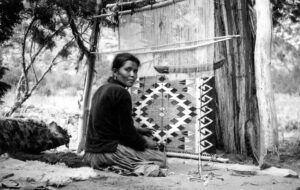The traditional “Storm” design appears on many Navajo textiles, appearing near Tuba City and Kayenta, Arizona, sometime between 1903 and 1911. The design is highly symbolic and its origins are shrouded by variations in familial, regional, and personal interpretations. The Storm pattern is associated with the seasonal rainstorms that bring about success during the growing season and is recognized as an interpretation of the Navajo creation story.

Instead of applying a central diamond motif—like many other Navajo weaving styles—the central element is often a rectangle, connected to the corners of the weaving with diagonal or zig-zag lines. This central element is often described as symbol for the center of the universe, the hogan (a traditional dwelling and ceremonial structure) or a lake. The zig-zag lines are recognized as symbols of lightning, which bestow blessings on the weaver. The four corners, which are often highlighted as distinct design features, represent the four sacred mountains connecting the Navajo Nation or the four winds. Despite the well-defined design elements, you will see Storm weavings in a variety of colored yarns.

“The People’s Tapestry: Weaving Tradition in Navajo Culture” is now on display at the Moab Museum, featuring a variety of Navajo textile styles, including the Storm design. In this column throughout the summer, the Museum team will feature a variety of weaving styles and their associated backgrounds and stories.
This exhibition is a celebration of the magnificent weavings created by the Diné (which means “the people” in Navajo). Diné textiles reflect the concept of hózhóó, or balance and harmony, expressed in primarily symmetrical designs. The significance of Diné textiles transcends artistic expression; weavers beautify their world through the spiritual act of weaving and integrate their art into the web of everyday life. The Navajo weaver’s song declares, “with beauty, it is woven.”
The Moab Museum is dedicated to sharing stories of the natural and human history of the Moab area. This is part of a series highlighting distinct textiles and styles displayed in the Museum’s temporary exhibition “The People’s Tapestry,” displayed summer-fall 2023. To explore more of Moab’s stories and artifacts, find out about upcoming programs, and become a Member, visit www.moabmuseum.org.




